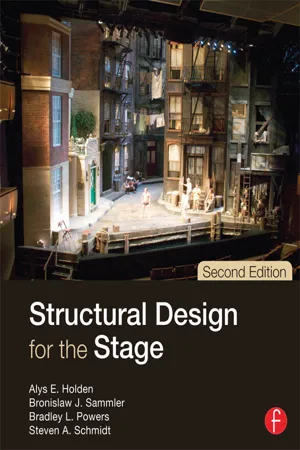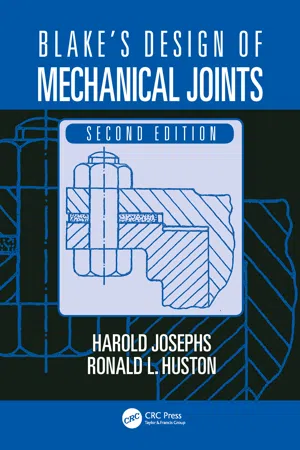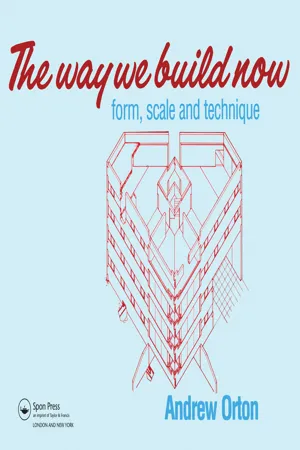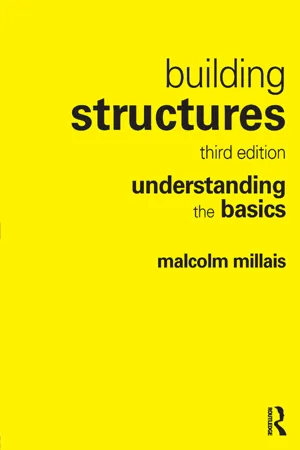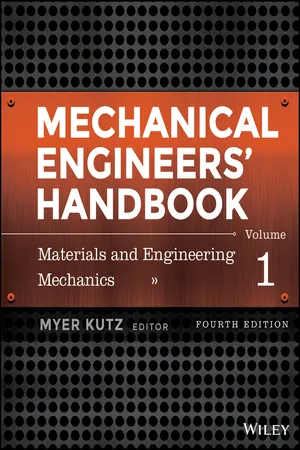Technology & Engineering
Shear Stress in Beams
Shear stress in beams refers to the force that causes one layer of the beam to slide relative to an adjacent layer. It is a result of the internal forces within the beam and is important for determining the beam's strength and stability. Shear stress is a critical consideration in the design and analysis of beams in engineering and construction.
Written by Perlego with AI-assistance
Related key terms
Related key terms
1 of 4
Related key terms
1 of 3
9 Key excerpts on "Shear Stress in Beams"
- eBook - ePub
Design-Tech
Building Science for Architects
- Thomas Leslie, Robert Whitehead(Authors)
- 2014(Publication Date)
- Routledge(Publisher)
Chapter 24 .Internal Resistance to Shear
Besides bending, beams must also be designed with a resistance against shear failure. Shear force deforms an object's shape by attempting to make adjacent planes within a structure slide past each other. Shear stress can be found in many different situations and scales: a bolted connection between two members sliding with respect to each other, at the conjunction of a column and slab, in the diagonal cracking of a compressive element, or even in the behavior of a simple paper punch.There are two types of possible shear in beams, vertical shear or horizontal shear. Horizontal shear is the tendency of materials to slide in layers relative to each other—in practice, it is rarely is a concern unless the material used for the spanning member was weakly laminated longitudinally (like early glu-lam wooden structures). Horizontal shear might best be envisioned as the mechanism that ties the foreshortened compression edge of a beam to the elongated tension edge. In other words, horizontal shear is the result of the internal “force couple” that resists bending. Vertical shear is caused by the opposing vertical forces of the loads and supports trying to slice through the beam material (see Figure 22.4 of a beam with horizontal boxes and layers).22.4 Vertical and horizontal shear failures.Shear failure is typically a concern for beams at, or near, its supports because the reaction force and loading are pushing in opposite directions in close proximity to each other. Interestingly, however, shear failure is rarely manifest as either a purely horizontal or vertical fracture—instead, most shear failures occur diagonally. This behavior can be attributed to the combined effect of both horizontal and vertical shear forces acting simultaneously in a beam. This behavior is best described by selecting a random square area from the side elevation of a beam and looking at how these shear forces acting in concert attempt to distort, or skew, its shape (Figure 22.5 - eBook - ePub
- Robert L. Mott, Joseph A. Untener(Authors)
- 2021(Publication Date)
- CRC Press(Publisher)
8 Shearing Stresses in BeamsThe Big Picture8–1 Objectives of This Chapter8–2 Importance of Shearing Stresses in Beams8–3 General Shear Formula8–4 Distribution of Shearing Stress in Beams8–5 Development of the General Shear Formula8–6 Special Shear Formulas8–7 Design for Shear8–8 Shear FlowThe Big Picture Discussion Map-
In Chapter 8 , your goal is to continue to develop your ability to analyze and design beams, but now in terms of shearing stresses that occur as a result of bending loads.
-
For a beam to be safe, it must satisfy design stress limits for both bending stresses and shearing stresses . In most cases, the bending stress is the most critical. But shearing stresses must always be checked, and as discussed in Section 8–2 , there are some important situations where shearing stresses are the predominant mode of failure.
-
You’ve already studied vertical shearing forces, but if a small stress element subjected to such shearing stresses is isolated, as shown in Figure 8–3 , it can be seen that horizontal shearing stresses must also exist in order to cause the element to be in equilibrium. Thus, both vertical and horizontal shearing stresses, having the same magnitude at a given point, are created by shearing stresses in beams.
The last few chapters have led to the analysis and design of beams loaded in bending with regard to normal stresses, that is tension and compression. For most beams, normal stress is the most likely to cause failure. Some beams, however, are susceptible to failure in shear - eBook - ePub
- Alys Holden, Bronislaw Sammler, Bradley Powers, Steven Schmidt(Authors)
- 2015(Publication Date)
- Routledge(Publisher)
3 Stress Analysis for BeamsDOI: 10.4324/9781315697857-3Introduction
Beam Stress
Beams are structural members which are subject to tangential loads. Tangential loads act perpendicular to the axis of a member and cause bending (flexure), vertical shear, and horizontal shear stresses to develop in a beam. As discussed in Chapter 2 , bending stress is actually a combination of tensile and compressive stresses. However, instead of analyzing the tensile and compressive stresses separately, bending stress can be treated as a whole with its own allowable stress design value. Bending stress is dependent on the loading condition on the beam and the resulting moment, and the shape of the beam. In this chapter, we will discuss how to calculate the magnitude of the bending and shear stresses generated by tangential loads on beams. In the next chapter we will discuss how to calculate the capacity of a shape to resist stresses.Types of Beam Failure
Beams can fail catastrophically in three ways: bending, horizontal shear, or vertical shear. Structural designers must analyze all three stresses in beams to be sure that they are safe.-
When a beam fails due to bending stress, the bottom fibers of the beam literally pull apart. A beam is more likely to fail due to bending stress if it has a relatively long span.
Figure 3.1a Bending stressShape affects a beam’s resistance to bending stress. A 2×4 beam oriented on edge will resist bending better than a 2×4 oriented flat, which is why 2×4 framed platforms are built with the framing on edge (3.5″ high).
-
When a beam fails due to horizontal shear, the top and bottom fibers slide past each other at the middle of the beam’s cross-section. Short beams are more likely to fail due to horizontal shear.
For solid sections, horizontal shear stress is not dependent on shape, only on cross-sectional area. An indication of failure due to horizontal shear would be a crack in the middle of a wooden beam, often following the grain of the lumber.
- eBook - ePub
- Harold Josephs, Ronald L. Huston(Authors)
- 2018(Publication Date)
- CRC Press(Publisher)
There are several reasons for this: First, textbook examples generally have relatively simple shapes—often different and far simpler in complexity than components typically found in “real-world” mechanical systems. Secondly, the issues of safety and economic concerns are seldom considered in text problems. Finally, tables of material values typically represent optimal values at a single measured point, assuming no defects in the materials, nor any difference for other values in the spectrum beyond the specific point measured.The literature on structural analysis and mechanics of materials contains a number of stress definitions and descriptive terms such as: “direct stress,” “bending,” “flexure,” “torsion,” “twist,” “transverse shear,” “ultimate stress,” “principal stress,” “primary,” or “secondary stresses” and others. In reality, however, there can only be two basic kinds of stress: normal and shear when we consider a state of stress at a given point of a mechanical system. At a given cross-sectional plane of a structure the normal stress is, of course, that which is perpendicular to that plane, while the shear stress acts along the given plane. In a simple beam, loaded in the transverse direction (perpendicular to the long axis of the beam), the normal stress is that which is perpendicular to the transverse cross-section or, in other words, the normal stress is directed along the axis of the beam. We recall that a simple beam is considered to be a 2-D component.The familiar bending stress of σ = MC /I , known to design engineers, is simply a normal stress at the section where the bending stress is considered. The transverse stress at this location, on the other hand, is the shear stress which acts at 90° to the normal stress just described. These two stresses, of course, can be combined according to a suitable strength of materials theory depending on the type of stresses and the materials from which the component is made.For example, if the material is brittle, we will initiate our analysis by first examining the maximum normal stress in our failure considerations. Alternatively, if the material is ductile, we will focus upon the shear stresses. We will discuss failure in greater detail later in this chapter. - eBook - ePub
The Way We Build Now
Form, Scale and Technique
- Andrew Orton(Author)
- 2013(Publication Date)
- Taylor & Francis(Publisher)
There are only two types of these stresses, direct stresses and shear stresses. Consider, for example, a very small rectangular area in the web of a steel beam (2.6). A direct stress is any tensile or compressive stress which acts across any of the four faces while a shear stress is one which acts along any of the four ‘cut’ faces of the small rectangular area. The direct stresses acting at any cross-section taken through a structural member add up to give the axial force and bending moment acting at that section; the shear stresses add up to give the shear and torsion acting at that section. I n some cases the stress resultants are zero: for a tie in tension there is no bending moment however the section through it is taken (2.32), the direct stresses all adding up to give a resultant tension force; for an element in simple torsion there is no shear force, the shear stresses all adding up to give a resultant torsional moment (2.7); if the section warps when twisted, then the direct stresses will also contribute to the resultant torsional moment (2.8). Direct stesses of tension or compression cause any small rectangular element in a member to elongate or to contract in the two directions perpendicular to the two sides, while shear stresses cause the small rectangular element to ‘lozenge’ (2.7). For example in the web of the steel beam each small area in the depth of the web is ‘lozenged’ by the action of the shear force (2.9). The shear stresses acting along the horizontal and vertical faces of each small rectangular area are equal, or very nearly equal, to each other and act so that each small element is always in equilibrium (2.6). The deflection of a steel beam under load is the result both of such ‘lozenging’ of these small rectangular elements, due to shear force, as well as the elongation and contraction of the elements due to bending (2.10) - eBook - ePub
Building Structures
understanding the basics
- Malcolm Millais(Author)
- 2017(Publication Date)
- Routledge(Publisher)
The effect of shear stresses on beams has been described in section 4.3. Fig. 4.40 shows that shear stresses may also cause twisting even when only vertical loads are present. This is because of another section property called the shear centre. The shear centre is the point through which the load axis must pass to avoid any twisting caused by the shear stress distribution. (Conversely the shear centre is the point about which the section will twist if loaded with twisting loads – see sections 2.8 and 3.6.) For doubly symmetric or skew symmetric cross-sections, the shear centre will coincide with the centre of area. For cross-sections with only one axis of symmetry, the shear centre will be on this axis of symmetry but will not in general coincide with the centre of area. Fig. 4.60 Shear centres Three important section properties of cross-sectional shapes have been identified, and these are: • Position of the centre of area • Directions of the principal axes • Position of the shear centre For doubly symmetric cross-sections these properties are readily found, but for general cross-sectional shapes these properties can only be found by calculation. Knowing these section properties, the distributions of axial, bending and shear stress can be drawn provided the assumptions of the Engineer’s theory are used. Even when the Engineer’s theory is used, for structural elements of general cross-sectional shape, the structural behaviour is quite complex. If the element itself is curved or varies in cross-sectional shape along its length, engineering analysis, both conceptual and mathematical, rapidly becomes extremely difficult. This analysis is the subject matter of advanced texts or even research papers. 4.6 Torsion and warping of open sections Some of the effects of twisting one-dimensional elements have already been described in sections 2.8, 3.6 and 4.1. In section 3.7 it was seen that torsion can also occur in curved elements - eBook - ePub
Mechanical Engineers' Handbook, Volume 1
Materials and Engineering Mechanics
- Myer Kutz, Myer Kutz(Authors)
- 2015(Publication Date)
- Wiley(Publisher)
A beam. is selected tentatively and checked for shear. Maximum shearing stress (horizontal and vertical) is at the neutral surface over the supports. Equation (34) for horizontal shear in a solid rectangular beam is, and, when. If the safe horizontal unit shearing stress for common-grade southern yellow pine is 88 psi and since the actual horizontal unit shearing stress is less than 88 lb, the. beam will be satisfactory. A beam of uniform strength is one in which the dimensions are such that the maximum fiber stress is the same throughout the length of the beam. The form of the beam is determined by finding the areas of various cross sections from the flexure formula, keeping constant and making I / c vary with. For a rectangular section of width and depth, the section modulus, and, therefore,. By making vary with, the dimensions of the various sections are obtained. Table 6 gives the dimensions and at any section, the maximum unit fiber stress, and the maximum deflection y of some rectangular beams of uniform strength. In this table, the bending moment has been assumed to be the controlling factor. On account of the vertical shear near the ends of the beams, the area of the sections must be increased over that given by an amount necessary to keep the unit shearing stress within the allowable unit shearing stress. The discussion of beams of uniform strength, although of considerable theoretical interest, is of little practical value since the cost of fabrication will offset any economy in the use of the material. A plate girder in a bridge or a building is an approximation in practice to a steel beam of uniform strength. Table 6 Rectangular Beams of Uniform Strength a 6.3 Continuous Beams As in simple beams, the expressions and govern the design and investigation of beams resting on more than two supports. In the case of continuous beams, however, the reactions cannot be obtained in the manner described for simple beams - eBook - ePub
- P.K. Jayasree, K Balan, V Rani(Authors)
- 2021(Publication Date)
- CRC Press(Publisher)
Figure 5.1 .FIGURE 5.1 Normal stress.Shear stress : Shear stress or shearing stress also known as tangential stress is caused by forces, which are parallel to force-resistant area. It differs from the normal stress mainly in the way in which it acts on a body. If F is the subsequent shearing force that passes through the center of area A , it is sheared as is shown in Figure 5.2 ,τ =(5.2)F AFIGURE 5.2 Shear stress.Bearing stress : It is the pressure of contact between different bodies which is shown in Figure 5.3 . The difference between bearing pressure and compressive stress is that while the former one is external pressure acting on the body, the latter is an internal stress caused by compressive forces.FIGURE 5.3 Bearing stress.5.1.3 Stress on an Oblique Plane Due to Axial Loading
As shown in Figure 5.4 , a section with normal plane at an angle of θ is drawn. The shearing stress and normal stress on this section can be calculated as:Normal component , F = P cos θ(5.3)Tangential component , V = P sin θ(5.4)Normal stress , σ =(5.5)P Acos 2θHighest shear stress or maximum shear strength occurs on planes, which makes an inclination of 45° or 175° with the normal cross section.Shear stress , τ =(5.6)P Asin θ cos θFIGURE 5.4 Axial loading stress on an oblique plane.5.2 Simple Strain
The strain is characterized as the change in length to the original length ratio. The transition in length is caused by the force applied.ε =(5.7)δ Lwhere δ is the deformation in length and L is the initial length, thus ε is the strain which is dimensionless. From Figure 5.5 - eBook - ePub
Mechanical Engineering Design
Third Edition
- Ansel C. Ugural(Author)
- 2020(Publication Date)
- CRC Press(Publisher)
Figure 3.13. Therefore,FIGURE 3.13 Shear stresses in a beam of rectangular cross-section.τ=maxVI bA *y ¯=V(bb)h 3/ 12b h2h 4=3 2V A(3.22) where A = bh is the cross-sectional area of a beam having depth h and width b . For narrow beams with sides parallel to the y axis, Equation (3.20) gives solutions in good agreement with the exact stress distribution obtained by the methods of the theory of elasticity. Equation (3.22) is particularly useful, since beams of rectangular section form are often employed in practice.The shear force acting across the width of the beam per unit length along the beam axis may be found by multiplying τxy in Equation (3.22) by b (Figure 3.11b ). This quantity is denoted by q , known as the shear flow ,q =V QI(3.23) This equation is valid for any beam having a cross-section that is symmetrical about the y axis. It is very useful in the analysis of built-up beams . A beam of this type is fabricated by joining two or more pieces of material. Built-up beams are generally designed on the basis of the assumption that the parts are adequately connected so that the beam acts as a single member. Structural connections are taken up in Chapter 15 .3.7.3.2 Various Cross-Sections
It should be noted that the shear formula, also called the shear stress formula, for beams is derived on the basis of the flexure formula. Hence, the limitations of the bending formula apply. A variety of cross-sections are treated upon following procedures similar to those for rectangular section discussed earlier and for a circular section (described in Example 3.11). Table 3.2 lists some common cases. Observe that shear stress can always be expressed as a constant times the average shear stress (P/A
Index pages curate the most relevant extracts from our library of academic textbooks. They’ve been created using an in-house natural language model (NLM), each adding context and meaning to key research topics.
Explore more topic indexes
Explore more topic indexes
1 of 6
Explore more topic indexes
1 of 4


